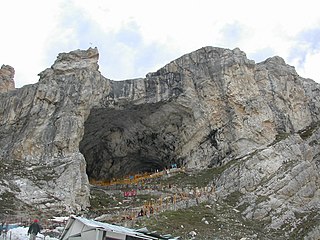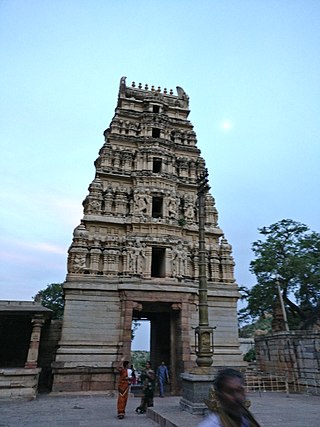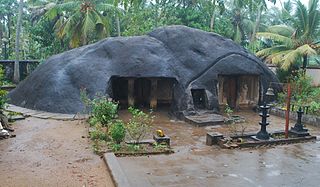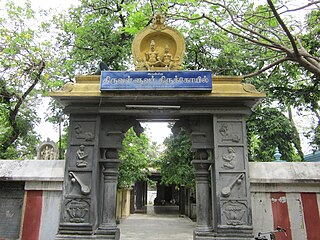
The Elephanta Caves are a collection of cave temples predominantly dedicated to the Hindu god Shiva, which have been designated a UNESCO World Heritage Site. They are on Elephanta Island, or Gharapuri, in Mumbai Harbour, 10 kilometres (6.2 mi) east of Mumbai in the Indian state of Mahārāshtra. The island, about 2 kilometres (1.2 mi) west of the Jawaharlal Nehru Port, consists of five Hindu caves, a few Buddhist stupa mounds that date back to the 2nd century BCE, and two Buddhist caves with water tanks.

Pachmarhi is a hill station in the Hoshangabad district of Madhya Pradesh state of central India. It has been the location of a cantonment since the British Raj. The municipality is located in a valley of the Satpura Range and is widely known as Satpura ki Rani.

The Satpura Range is a range of hills in central India. The range rises in eastern Gujarat running east through the border of Maharashtra and Madhya Pradesh and ends in Chhattisgarh. The range parallels the Vindhya Range to the north, and these two east–west ranges divide Indian Subcontinent into the Indo-Gangetic plain of northern India and the Deccan Plateau of the south. The Narmada River originates from north-eastern end of Satpura in Amarkantak, and runs in the depression between the Satpura and Vindhya ranges, draining the northern slope of the Satpura range, running west towards the Arabian Sea. The Tapti River originates in the eastern-central part of Satpura, crossing the range in the center and running west at the range's southern slopes before meeting the Arabian Sea at Surat, draining the central and southern slopes of the range. Multai, the place of Tapi river origin is located about 465 kilometer far, south-westerly to Amarkantak, separated across by the hill range. The Godavari River and its tributaries drain the Deccan plateau, which lies south of the range, and the Mahanadi River drains the easternmost portion of the range. The Godavari and Mahanadi rivers flow into the Bay of Bengal. At its eastern end, the Satpura range meets the hills of the Chotanagpur Plateau. The Satpura Range is a horst mountain and is flanked by Narmada Graben in the north and much smaller but parallel Tapi Graben in the south.

Gupteswar Cave is a cave shrine dedicated to Shiva. It is a pilgrim site situated about 55 km (34 mi) away Jeypore, Koraput District in the state of Odisha, India. It is a limestone cave, and its main attraction is the gigantic Shiva Linga which is said to be increasing in size. It is believed that the cave was discovered by Rama and re-discovered in the reign of Maharajah Veer Vikram Dev. In the holy month of Shravan, the cave is visited by devotees who walk to the shrine bare-footed with decorated bamboo palanquins called "Kanwadiya" and bathe in the maha kund before worshipping Lord Gupteshwar. There are 200 steps to reach to the Shiva linga temple. Its entrance is about 3 metres (9.8 ft) wide and 2 metres (6.6 ft) high.

Omkareshwar is a Hindu temple dedicated to Shiva, located in Mandhata, nearby Khandwa city in Khandwa district of the Indian state of Madhya Pradesh. It is one of the 12 revered Jyotirlinga shrines of Shiva. It is on an island called Mandhata, near Khandwa city in the Narmada river at Khandwa district in Madhya Pradesh, India; the shape of the island is said to be like the Devanagari ॐ symbol.

Amarnath Temple is a Hindu shrine located in the Pahalgam tehsil of the Anantnag district of Jammu and Kashmir, India. It is a cave situated at an altitude of 3,888 m (12,756 ft), about 168 km from Anantnag city, the district headquarters, 141 km (88 mi) from Srinagar, the summer capital of Jammu and Kashmir, reached through either Sonamarg or Pahalgam. It is an important shrine in Hinduism.

Gorakhnath was a Hindu yogi, saint who was the founder of the Nath Hindu monastic movement in India. He is considered one of the two disciples of Matsyendranath. His followers are known as Jogi, Gorakhnathi, Darshani or Kanphata.

Pahalgam, known as Pahalgom is a town and a notified area committee, near Anantnag city in the Anantnag district of the Indian-administered union territory of Jammu and Kashmir. It is a popular tourist destination and hill station. Its lush green meadows and pristine waters attract thousands of tourists from all over the world each year. It is located 45 kilometres (28 mi) from Anantnag on the banks of Lidder River at an altitude of 7,200 feet (2,200 m). Pahalgam is the headquarters of one of the eleven tehsils of Anantnag district.
Shujalpur is a city and a municipality in Shajapur district in the Indian state of Madhya Pradesh. Ranoji Rao Shinde, father of Mahadji Shinde (Scindia), died in 1745 at Shujalpur, where his cenotaph (chattri) stands which houses a Shiv temple. It is known as Ranoganj.
Sohagpur is a town and a nagar panchayat in Narmadapuram district in the Indian state of Madhya Pradesh. It is one of the subdivisions and development blocks in Narmadapuram district. Sohagpur is also one of the legislative constituencies of Madhya Pradesh. Sohagpur is famour for its Betel culture, and an enormous quantity of betel is exported from here.

Ugratara Devalaya is a temple dedicated to Ugratara located in the western side of Jor Pukhury tanks in the heart of Guwahati city in the Lotaxil (Latasil) locality in Northeast India. The Ugratara Temple in Uzan Bazaar in the eastern part of Guwahati, Assam, is a Shakti shrine. Legend has said that the navel of Sati, first consort of Shiva, is related to this temple. Ugratara in Assam is generally identified with Tiksna-Kanta, Eka-Jata, etc., of the Buddhist pantheon.
Bagli is a town and a nagar panchayat in the Malwa region of Dewas district in the state of Madhya Pradesh, India. Bagli is around 66 km (41 mi) from Dewas.

Yaganti Temple or Sri Yaganti Uma Maheswara Temple is a temple of Shiva in Nandyal district in the India state of Andhra Pradesh. It was built according to Vaishnavaite traditions.

Kottukkal Cave Temple, also known as Kaltrikkovil in Malayalam, is an existing example of rock cut architecture, built between 6th and 8th centuries CE. It is situated in the village of Kottukkal, near Anchal, Kollam district, Kerala in India. The name Kottukkal is a reference to rock cut shrine. There are two caves of unequal size, both facing the east with the sculpture of the main deity Ganapathy in between. The smaller cave has an idol of Hanuman and the larger one has a monolithic Nandi (bull) in it. Lord Shiva is also a deity in the temple in the form of a Shiva Ling.

The Ekambareswarar–Kamakshi Temple, commonly known as the Thiruvalluvar Temple, is a Hindu temple dedicated to the poet-saint Valluvar in the neighborhood of Mylapore in Chennai, India. The shrine is located within the Ekambareswarar temple complex. Believed to have been constructed in the early 16th century, the temple was extensively renovated in the 1970s. Traditionally believed to be the birthplace of Saint Valluvar, the temple is the oldest ever built to Valluvar. The temple also serves as the venue for meetings of Tamil language enthusiasts. While many consider the temple as the birthplace of Valluvar, some consider it as his samadhi.

Tapkeshwar Temple, also known as Tapkeshwar Mahadev Temple, is a temple in Dehradun dedicated to Shiva. The temple is on the bank of the Tons River, built on top of a natural cave, which holds the temple's main shivalinga.

Brahmagiri is a hill in the Western Ghats of Maharashtra. It is situated in Nashik District in the Indian state of Maharashtra. Trimbakeshwar Shiva Temple is located near this place. The origin of the Godavari river, which Hindus consider sacred, is near Trimbak. It flows for 1,465 kilometres (910 mi), first eastwards across the Deccan Plateau then turns southeast, entering the West Godavari district and East Godavari district of Andhra Pradesh, until it splits into two watercourses that widen into a large river delta and flow into the Bay of Bengal.
Asaladeebesvarar Temple is a Hindu temple dedicated to the deity Shiva, located at Mohanur in Namakkal district in Tamil Nadu, India.














